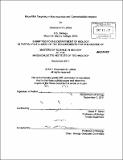MicroRNA targeting in mus musculus and Caenorhabditis elegans
Author(s)
Lafkas, Ginamarie N
DownloadFull printable version (4.179Mb)
Other Contributors
Massachusetts Institute of Technology. Dept. of Biology.
Advisor
David P. Bartel.
Terms of use
Metadata
Show full item recordAbstract
MicroRNAs (miRNAs) are small, approximately 22 nucleotide RNAs that regulate gene expression post-transcriptionally by base-pairing to complementary sites in the target mRNA. The first miRNA, lin-4, was discovered in 1993 in Caenorhabditis elegans; since then hundreds of miRNAs have been identified in C. elegans, Drosophila melanogaster, plants, mouse, and humans, where they approach a number equivalent to 1-2% of the protein-coding genes. With the exception of plants, miRNAs most commonly regulate targets by imperfectly pairing to 3' untranslated regions (UTRs), leading to translational repression or mRNA destabilization. The microRNA miR-196 is encoded at three paralogous locations in the HoxA, B, and C clusters in mammals and has conserved complementarity to the 3'UTRs of Hoxb8, Hoxc8, and Hoxa7; in particular, miR-1 96 has complete complementarity to Hoxb8 with the exception of a single G:U wobble. In 2004, Yekta et al., were able to detect RNA fragments diagnostic of miR-1 96-directed cleavage of Hoxb8 transcript in mouse embryos, and cell culture experiments showed down-regulation of Hoxb8, Hoxc8, Hoxd8, and Hoxa7. To address the biological significance of miR-196 mediated repression of Hox genes in vivo, we attempted to generate targeted transgenic mice for the Hoxa7, b8 and c8 genes. These mice would allow us to study the resulting phenotypic and molecular consequences and determine the impact this regulation has on establishment of the anterior-posterior axis in the developing embryo as well as its role in defining the expression boundaries of the individual Hox genes in vivo. The lin-4 miRNA plays a role in regulating the heterochronic genes involved in larval development in C. elegans. We used luciferase assays to test the efficacy of the seven proposed lin-4 binding sites in the lin-14 3'UTR and to determine if lin-4 is capable of recognizing and mediating repression through them. The wild-type lin-14 3'UTR was compared with mutant UTRs in which the lin-4 target sites were mutated. We determined that the three canonical 8mer sites are functional, as expected, and that at least one of the four additional sites is also recognized by lin-4 and contributes to the overall repression of the lin-14 3'UTR.
Description
Thesis (S.M.)--Massachusetts Institute of Technology, Dept. of Biology, 2011. Cataloged from PDF version of thesis. Includes bibliographical references (p. 45-52).
Date issued
2011Department
Massachusetts Institute of Technology. Department of BiologyPublisher
Massachusetts Institute of Technology
Keywords
Biology.